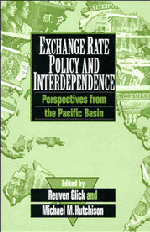Book contents
- Frontmatter
- Contents
- List of contributors
- Preface
- Exchange rate policy and interdependence
- 1 Overview
- I International financial market integration
- II Choice of exchange rate regimes
- III Intervention and sterilization policies
- 10 Monetary policy, intervention, and exchange rates in Japan
- 11 The signaling effect of foreign exchange intervention: the case of Japan
- 12 Sterilization of the monetary effects of current account surpluses and its consequences: Korea, 1986–1990
- IV Prospects for a yen bloc
- Index
11 - The signaling effect of foreign exchange intervention: the case of Japan
Published online by Cambridge University Press: 04 May 2010
- Frontmatter
- Contents
- List of contributors
- Preface
- Exchange rate policy and interdependence
- 1 Overview
- I International financial market integration
- II Choice of exchange rate regimes
- III Intervention and sterilization policies
- 10 Monetary policy, intervention, and exchange rates in Japan
- 11 The signaling effect of foreign exchange intervention: the case of Japan
- 12 Sterilization of the monetary effects of current account surpluses and its consequences: Korea, 1986–1990
- IV Prospects for a yen bloc
- Index
Summary
Introduction
Large–scale foreign exchange intervention by the central banks of major industrial countries since the Plaza Agreement has revived discussion concerning the effectiveness of official intervention. One of the common findings in the recent literature is the importance of the signaling channel of official intervention: market participants observing official intervention revise their expectations of future monetary policy, which induces a change in the current level of the exchange rate. For example, according to Dominguez and Frankel (1990), a $100 million of official intervention had an estimated effect of 4 percent on the exchange rate through the signaling channel, while the effect through the portfolio balance channel was less than 0.1 percent. Also, in a comparative discussion of the Carter administration's dollar support operations of late 1978 and the Plaza Agreement of 1985, Marston (1988) points out that the effectiveness of sterilized intervention depends crucially on the extent to which the intervention changes the market's expectations about future monetary policy. In the context of an incomplete–information game between market participants and a central bank with inside information about future monetary policy, the signaling hypothesis can be broken down into two parts.2 The first relates to the optimizing behavior of the central bank. Given a functional relationship between intervention signals and market expectations about future monetary policy, the central bank minimizes some well–specified loss function by choosing the amount of intervention. The second relates to the formation of market expectations about future monetary policy.
- Type
- Chapter
- Information
- Exchange Rate Policy and InterdependencePerspectives from the Pacific Basin, pp. 258 - 286Publisher: Cambridge University PressPrint publication year: 1994
- 9
- Cited by



